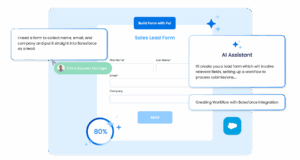When your data is clean, your systems run smoother, your workflows become more efficient, and your AI tools deliver better insights. That was the central message of FormAssembly’s recent customer webinar, “Squeaky Clean Data: Using Validation Tools to Boost Your Business-Critical Forms.”
The webinar explored the importance of data validation and offered hands-on demonstrations of key FormAssembly form-building features designed to prevent errors, reduce friction, and protect your downstream systems.
You can access the full presentation on demand here or read on for the highlights!
What is Form Validation and Why is it So Important?
Form validation is the process of checking user input to ensure it’s accurate, complete, and properly formatted before submission. Think of it as a built-in quality control system for your web forms. It’s not just a technical feature – it’s a frontline defense against the messy, inconsistent, and error-prone data that can slow down your business or undermine your AI initiatives.
When used well, validation:
- Protects your CRM and systems from bad or mismatched data
- Reduces the need for manual cleanup
- Improves the respondent experience by guiding users to enter correct information
- Enables AI tools to produce better outcomes by ensuring clean input data
Validation Starts with Smart Form Design
Validation doesn’t always mean writing code. Much of it starts with simple, intentional design choices:
- Dropdown menus that help enforce consistent input that aligns with your backend systems
- Radio buttons that eliminate ambiguity
- Date pickers and field masking that ensure standardized formats (like “MM/DD/YYYY”)
- Predefined content that allows you to add fields like phone numbers or emails with include built-in validation
Even the smallest decisions, like using a dropdown instead of an open text field, can make a big impact on data quality.
Custom Validation with Regular Expressions (RegEx)
For advanced use cases, FormAssembly supports custom validation through RegEx. This lets you define exactly what type of data is allowed in a given field. One live example from the webinar showed how to allow only @formassembly.com email addresses in a form – this is a perfect use case for internal forms or access restrictions.
Pro Tip: Use a RegEx testing site like regex101.com to validate your expressions before adding them to your form. FormAssembly also provides documentation and examples to help you get started.
Conditional Logic and Smart Error Messages
Validation isn’t just about preventing bad data; it’s also about improving the respondent experience.
The webinar showcased how to improve the respondent experience by:
- Using conditional rules to show or hide fields based on a user’s response (e.g., a shipping address field that only appears if it differs from the billing address)
- Customizing error messages to guide users clearly without revealing how to bypass rules
- Using hidden fields with validation to help detect spam or bot submissions
These small but powerful touches make your forms smarter and more user-friendly.
Key Takeaways for Better Data Collection
Form validation isn’t just a box to check during form setup – it’s a foundational part of your data strategy. Whether you’re building a simple contact form or preparing data for AI analysis, consider the following:
- Start simple. Master required fields, field types, and predefined content first.
- Build gradually. Add conditional logic and custom validation as needed.
- Test like a user. Submit test data, try to break your forms, and catch issues early.
- Think downstream. Design your forms with your CRM, marketing tools, and AI in mind.
Clean data is powerful data – and validation is how you get there.
Want to Learn More?
If you’re ready to start building smarter forms with stronger validation, check out FormAssembly’s Knowledge Base for step-by-step guides and examples.
